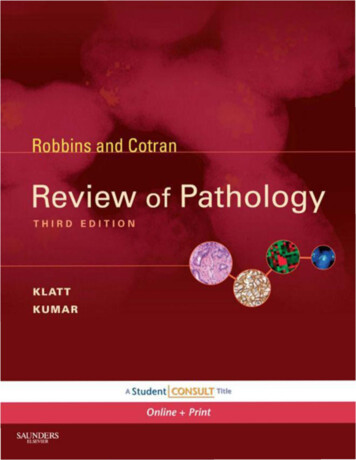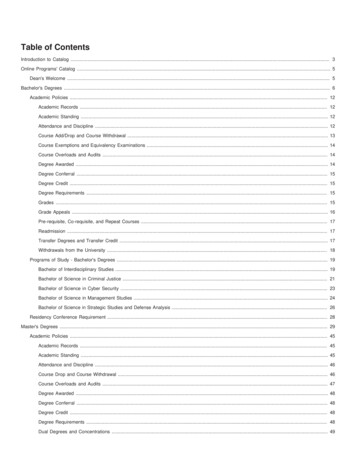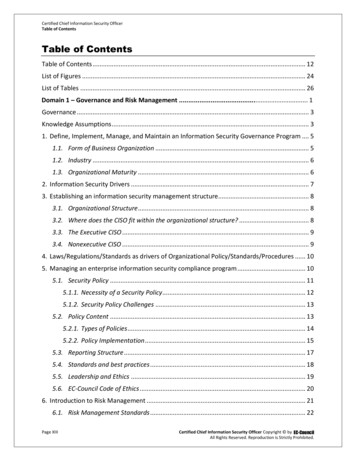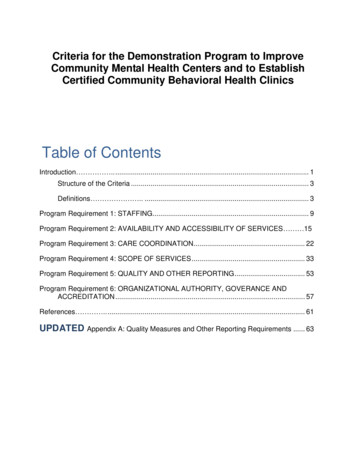
Transcription
Criteria for the Demonstration Program to ImproveCommunity Mental Health Centers and to EstablishCertified Community Behavioral Health ClinicsTable of ContentsIntroduction . . 1Structure of the Criteria . 3Definitions . . 3Program Requirement 1: STAFFING. 9Program Requirement 2: AVAILABILITY AND ACCESSIBILITY OF SERVICES 15Program Requirement 3: CARE COORDINATION. 22Program Requirement 4: SCOPE OF SERVICES . 33Program Requirement 5: QUALITY AND OTHER REPORTING . 53Program Requirement 6: ORGANIZATIONAL AUTHORITY, GOVERANCE ANDACCREDITATION . 57References . . 61UPDATED Appendix A: Quality Measures and Other Reporting Requirements . 63
IntroductionOn April 1, 2014, the Protecting Access to Medicare Act of 2014 (hereinafter “PAMA” or“the statute”) was signed into law. Among other things, PAMA requires theestablishment of demonstration programs to improve community behavioral healthservices, to be funded as part of Medicaid (PAMA, § 223). PAMA specifies criteria forcertified community behavioral health clinics to participate in demonstration programs.These criteria fall into six areas: (1) staffing, (2) availability and accessibility of services,(3) care coordination, (4) scope of services, (5) quality and other reporting, and (6)organizational authority. The criteria within this document address each of the areas.The behavioral health clinics participating in this demonstration program and meetingcriteria will be known as Certified Community Behavioral Health Clinics (CCBHCs).The CCBHCs represent an opportunity for states1 to improve the behavioral health oftheir citizens by: providing community-based mental and substance use disorderservices; advancing integration of behavioral health with physical health care;assimilating and utilizing evidence-based practices on a more consistent basis; andpromoting improved access to high quality care. Care coordination is the linchpinholding these aspects of CCBHC care together and ensuring CCBHC care is, indeed,an improvement over existing services. Enhanced federal matching funds madeavailable through this demonstration for services delivered to Medicaid beneficiariesoffer states the opportunity to expand access to care and improve the quality ofbehavioral health services.PAMA is clear that, regardless of condition, CCBHCs are to provide services to all whoseek help, but it is anticipated the CCBHCs will prove particularly valuable forindividuals with serious mental illness (SMI), those with severe substance usedisorders, children and adolescents with serious emotional disturbance (SED), andthose with co-occurring mental, substance use or physical health disorders. Those whoare most in need of coordinated, integrated quality care will receive it from CCBHCs.The statute directs the care provided by CCBHCs be “patient-centered.” It is expectedCCBHCs will offer care that is person-centered and family-centered in accordance withThe term “State” is defined in the statute (PAMA § 233(e)(4)) as having “the meaning given such term for purposesof title XIX of the Social Security Act (42 U.S.C. 1396 et seq.).11
the requirements of section 2402(a) of the Affordable Care Act (ACA), trauma-informed,and recovery-oriented, and that the integration of physical and behavioral health carewill serve the “whole person” rather than simply one disconnected aspect of theindividual. The criteria are infused with these expectations and states are encouragedto certify clinics providing care consistent with these principles.Although the CCBHC demonstration program and Prospective Payment System (PPS)are designed to work within the scope of state Medicaid Plans and to apply specificallyto individuals who are Medicaid enrollees, the statute also requires the CCBHCs not torefuse service to any individual on the basis of either ability to pay or place of residence.In addition to these requirements for inclusive service, CCBHCs will serve persons forwhom services are court ordered.2 These conditions, together with the fact thatimproving access to and the quality of health care for the Medicaid population also maypositively affect the health of others through changes in overall methods of caredelivery, means the CCBHC demonstration program may have long lasting andbeneficial effects beyond the realm of Medicaid enrollees.These criteria were developed based on a review of selected state Medicaid Plans,standards for Federally Qualified Health Centers and Medicaid Health Homes, andquality measures currently in use by states. The criteria were refined and finalizedthrough a public participatory process that occurred between November 2014 andMarch 2015, and included a National Listening Session, consultation with tribal leaders,written public comments, and solicitation for public response on the Substance Abuseand Mental Health Services Administration (SAMHSA) website.3The criteria are intended to extend quality and to improve outcomes of the behavioralhealth care system within the authorities of state regulations, statutes and stateMedicaid Plans. These criteria establish a basic level of services at which the CCBHCsshould, at a minimum, operate. They allow the states flexibility in determining how toimplement the criteria in a manner best addressing the needs of the population beingserved. The criteria are designed to encourage states and CCBHCs to further developtheir abilities to offer behavioral health services that comport with current best practices.Thus, the criteria set high expectations which are likely to require changes and2This program does not extend Medicaid coverage or payment to inmates of correctional institutions.3Also see guidance issued by CMS regarding the state PPS to be used as part of the demonstration program(PAMA, § 223(b)).2
adjustments to current service delivery systems. SAMHSA recognizes state behavioralhealth programs vary widely in structure, content, funding and organization, and stateMedicaid programs also differ widely. Consequently, there will be differences in theease with which states can meet the criteria specified for this program. AlthoughSAMHSA, in collaboration with staff in the Centers for Medicare & Medicaid Services(CMS) and the Assistant Secretary for Planning and Evaluation (ASPE), plans to selectstates for the demonstration program that can best satisfy the goals of PAMA, it alsointends to consider carefully the extent to which applicant states are positioned to makesubstantial strides in care, using the demonstration program to improve access andquality of care.Structure of the CriteriaEach program requirement corresponds to a section of PAMA, with the statutoryauthority for each program requirement identified at the beginning of the pertinentsection. Also within the criteria, are “Notes.” In some instances, Notes areclarifications of a criterion. In other instances, Notes provide states an opportunity toexplain why a criterion may not be satisfied.DefinitionsImportant terms used in these criteria are defined below. SAMHSA recognizes statesmay have existing definitions of the terms included here and these definitions are notintended to supplant state definitions to the extent a state definition is more specific orencompasses more than the definition used here.Agreement: As used in the context of care coordination, an agreement is anarrangement between the CCBHC and external entities with which care iscoordinated. Such an agreement is evidenced by a contract, Memorandum ofAgreement (MOA), or Memorandum of Understanding (MOU) with the otherentity, or by a letter of support, letter of agreement, or letter of commitment fromthe other entity. The agreement describes the parties’ mutual expectations andresponsibilities related to care coordination.Behavioral health: Behavioral health is a general term “used to refer to both mentalhealth and substance use” (SAMHSA-HRSA [2015]).Care coordination: The Agency for Healthcare Research and Quality (2014) definescare coordination as “deliberately organizing consumer care activities andsharing information among all of the participants concerned with a consumer’scare to achieve safer and more effective care. This means the patient’s needsand preferences are known ahead of time and communicated at the right time tothe right people, and that this information is used to provide safe, appropriate,3
and effective care to the patient.” As used here, the term applies to activities byCCBHCs that have the purpose of coordinating and managing the care andservices furnished to each consumer as required by PAMA (including bothbehavioral and physical health care), regardless of whether the care and servicesare provided directly by the CCBHC or through referral or other affiliation withcare providers and facilities outside the CCBHC. Care coordination is regardedas an activity rather than a service.Case management: Case management may be defined in many ways and canencompass services ranging from basic to intensive. The National Association ofState Mental Health Program Directors (NASMHPD) defines case managementas “a range of services provided to assist and support individuals in developingtheir skills to gain access to needed medical, behavioral health, housing,employment, social, educational and other services essential to meeting basichuman services; linkages and training for patient served in the use of basiccommunity resources; and monitoring of overall service delivery” (NASMHPD[2014]). See also the definition of “targeted case management.”CCBHC or Clinic: CCBHC and Clinic are used interchangeably to refer to CertifiedCommunity Behavioral Health Clinics as certified by states in accordance withthese criteria and with the requirements of PAMA. A CCBHC may offer servicesin different locations. For multi-site organizations, however, only clinics eligiblepursuant to these criteria and PAMA may be certified as CCBHCs.CCBHC directly provides: When the term, “CCBHC directly provides” is used withinthese criteria it means employees or contract employees within the managementstructure and under the direct supervision of the CCBHC deliver the service.Consumer: Within this document, the term “consumer” refers to clients, personsbeing treated for or in recovery from mental and/or substance use disorders,persons with lived experience, service recipients and patients, all usedinterchangeably to refer to persons of all ages (i.e., children, adolescents,transition aged youth, adults, and geriatric populations) for whom health careservices, including behavioral health services, are provided by CCBHCs. Use ofthe term “patient” is restricted to areas where the statutory or other language isbeing quoted. Elsewhere, the word “consumer” is used.Cultural and linguistic competence: Culturally and linguistically appropriateservices are respectful of and responsive to the health beliefs, practices andneeds of diverse consumers (Office of Minority Health [2014]).4
Designated Collaborating Organization (DCO): A DCO is an entity that is not underthe direct supervision of the CCBHC but is engaged in a formal relationship withthe CCBHC and delivers services under the same requirements as the CCBHC.Payment for DCO services is included within the scope of the CCBHC PPS, andDCO encounters will be treated as CCBHC encounters for purposes of the PPS.The CCBHC maintains clinical responsibility for the services provided for CCBHCconsumers by the DCO. To the extent that services are required that cannot beprovided by either the CCBHC directly or by a DCO, referrals may be made toother providers or entities. The CCBHC retains responsibility for carecoordination including services to which it refers consumers. Payment for thosereferred services is not through the PPS but is made through traditionalmechanisms within Medicaid.Engagement: Engagement includes a set of activities connecting consumers withneeded services. This involves the process of making sure consumers andfamilies are informed about and initiate access with available services and, onceservices are offered or received, individuals and families make active decisionsto continue receipt of the services provided. Activities such as outreach andeducation can serve the objective of engagement. Conditions such asaccessibility, provider responsiveness, availability of culturally and linguisticallycompetent care, and the provision of quality care, also promote consumerengagement.Family: Families of both adult and child consumers are important components oftreatment planning, treatment and recovery. Families come in different formsand, to the extent possible, the CCBHC should respect the individual consumer’sview of what constitutes their family. Families can be organized in a wide varietyof configurations regardless of social or economic status. Families can includebiological parents and their partners, adoptive parents and their partners, fosterparents and their partners, grandparents and their partners, siblings and theirpartners, care givers, friends, and others as defined by the family.Family-centered: The Health Resources and Services Administration defines familycentered care, sometimes referred to as “family-focused care,” as “an approachto the planning, delivery, and evaluation of health care whose cornerstone isactive participation between families and professionals. Family-centered carerecognizes families are the ultimate decision-makers for their children, withchildren gradually taking on more and more of this decision-making themselves.When care is family-centered, services not only meet the physical, emotional,developmental, and social needs of children, but also support the family’srelationship with the child’s health care providers and recognize the family’s5
customs and values” (Health Resources and Services Administration [2004]).More recently, this concept was broadened to explicitly recognize family-centeredservices are both developmentally appropriate and youth guided (AmericanAcademy of Child & Adolescent Psychiatry [2009]). Family-centered care isfamily-driven and youth-driven.Formal relationships: As used in the context of scope of services and therelationships between the CCBHC and DCOs, a formal relationship is evidencedby a contract, Memorandum of Agreement (MOA), Memorandum of Understanding(MOU), or such other formal arrangements describing the parties’ mutualexpectations and establishing accountability for services to be provided andfunding to be sought and utilized. This formal relationship does not extend toreferrals for services outside either the CCBHC or DCO, which are notencompassed within the reimbursement provided by the PPS.Limited English Proficiency (LEP): LEP includes individuals who do not speakEnglish as their primary language or who have a limited ability to read, write,speak, or understand English and who may be eligible to receive languageassistance with respect to the particular service, benefit, or encounter.Peer Support Services: Peer support services are services designed and deliveredby individuals who have experienced a mental or substance use disorder and arein recovery. This also includes services designed and delivered by familymembers of those in recovery.Peer Support Specialist: A peer provider (e.g., peer support specialist, recoverycoach) is a person who uses their lived experience of recovery from mental orsubstance use disorders or as a family member of such a person, plus skillslearned in formal training, to deliver services in behavioral health settings topromote recovery and resiliency. In states where Peer Support Services arecovered through the state Medicaid Plans, the title of “certified peer specialist”often is used. SAMHSA recognizes states use different terminology for theseproviders.Person-centered care: Person-centered care is aligned with the requirements ofSection 2402(a) of the Patient Protection and Affordable Care Act, asimplemented by the Department of Health & Human Services Guidance to HHSAgencies for Implementing Principles of Section 2403(a) of the Affordable CareAct: Standards for Person-Centered Planning and Self-Direction in Home andCommunity-Based Services Programs (Department of Health & Human Services[June 6, 2014]). That guidance defines “person-centered planning” as a processdirected by the person with service needs which identifies recovery goals,6
objectives and strategies. If the consumer wishes, this process may include arepresentative whom the person has freely chosen, or who is otherwiseauthorized to make personal or health decisions for the person. Person-centeredplanning also includes family members, legal guardians, friends, caregivers, andothers whom the person wishes to include. Person-centered planning involvesthe consumer to the maximum extent possible. Person-centered planning alsoinvolves self- direction, which means the consumer has control over selectingand using services and supports, including control over the amount, duration,and scope of services and supports, as well as choice of providers (Departmentof Health & Human Services [June 6, 2014]).Practitioner or Provider: Any individual (practitioner) or entity (provider) engaged inthe delivery of health care services and who is legally authorized to do so by thestate in which the individual or entity delivers the services (42 CFR § 400.203).Recovery: Recovery is defined as “a process of change through which individualsimprove their health and wellness, live a self-directed life, and strive to reachtheir full potential.” The 10 guiding principles of recovery are: hope; persondriven; many pathways; holistic; peer support; relational; culture; addressestrauma; strengths/responsibility; and respect. Recovery includes: Health(abstinence, ”making informed healthy choices that support physical andemotional wellbeing”); Home (safe, stable housing); Purpose (“meaningful dailyactivities and the independence, income and resources to participate insociety”); and Community (“relationships and social networks that providesupport, friendship, love, and hope”) (Substance Abuse and Mental HealthServices Administration [2012]).Recovery-oriented care: Recovery-oriented care is oriented toward promoting andsustaining a person's recovery from a behavioral health condition. Careproviders identify and build upon each individual’s assets, strengths, and areas ofhealth and competence to support the person in managing their condition whileregaining a meaningful, constructive sense of membership in the broadercommunity (Substance Abuse and Mental Health Services Administration[2015]).Shared Decision-Making (SDM): SDM is an approach to care through whichproviders and consumers of health care come together as collaborators indetermining the course of care. Key characteristics include having the healthcare provider, consumer, and sometimes family members and friends actingtogether, including taking steps in sharing a treatment decision, sharing7
information about treatment options, and arriving at consensus regardingpreferred treatment options (Schauer, Everett, delVecchio, & Anderson [2007]).Targeted case management: Targeted case management is case management, asdefined above, directed at specific groups, which may vary by state. CMSdefines targeted
establishment of demonstration programs to improve community behavioral health services, to be funded as part of Medicaid (PAMA, § 223). PAMA specifies criteria for certified community behavioral health clinics to participate in demonstration programs. These criteria fall into six areas: (1) staffing, (2) availability and accessibility of .
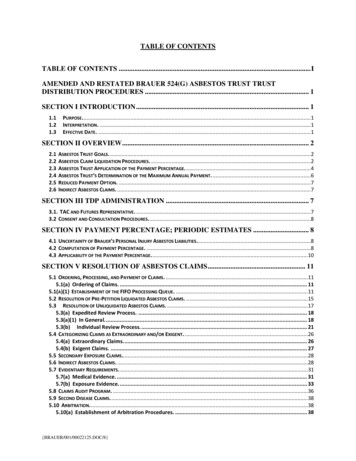

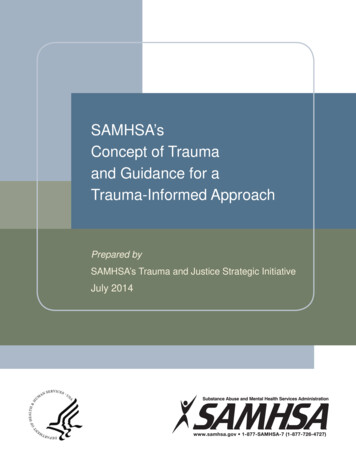
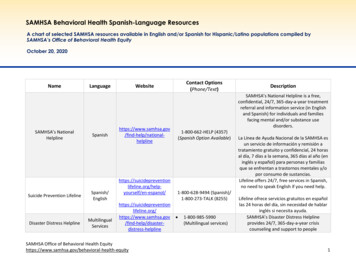
![[NAME OF STATE] - SAMHSA](/img/8/state-certification-guide.jpg)
